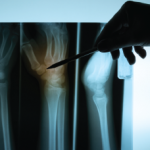For years, guidelines from various organizations have recommended osteoporosis screening in women and men starting at a specific age or based on specific risk factors. Among these guidelines are those developed by the U.S. Preventive Services Task Force (USPSTF) that recommend universal osteoporosis screening for women 65 years of age and older and for targeted screening in all women younger than 65 years with risk factors for osteoporosis.1
Despite efforts to improve utilization of osteoporosis screening, data from two recent studies confirm what is now well documented: Utilization remains woefully low, even in women following a first hip fracture.
“Our findings underscore the persistent failure to align real-world implementation of osteoporosis screening among older women with evidence-based guidelines,” says Catherine Gillespie, PhD, MPH, AARP Public Policy Institute, Washington, D.C.

Dr. Gillespie
Dr. Gillespie, along with coinvestigator Pamela E. Morin, MBA, conducted the studies to look at utilization of osteoporosis screening in two patient cohorts. Both studies looked at contemporary trends and patterns of osteoporosis screening in privately insured women in the U.S. aged 50 years and older.2,3 One study looked at utilization trends in 1,638,454 women with no prior history of osteoporosis diagnosis, drug use for osteoporosis or hip fracture.2 A second study examined trends in utilization of osteoporosis-related health services, including screening, within six to 12 months following first-time hip fracture in a cohort of 8,349 women.3
Both studies found deficiencies in how osteoporosis screening is being implemented, with each study providing important information on specific patterns of underutilization.
Primary Prevention
With the aim of describing patterns of osteoporosis screening in U.S. women aged 50 and older with no prior history of osteoporosis, Dr. Gillespie and Ms. Morin retrospectively looked at screening rates between 2008 and 2014 among 1,638,454 U.S. women grouped into three age groups: 50–64 years, 65–79 years and 80+ years.2
The study found that overall screening rates remain low in all three age groups, with 21.1% of women screening in the 50–64-year-old age group, 26.5% in the 65–79-year-old age group, and 12.8% in women aged 80 and older. However, the study found that year-over-year changes in screening utilization in two age groups were in line with national recommendations, showing that screening rates in these age groups are moving in the right direction, says Dr. Gillespie. Although still low, screening rates increased by 38% for women aged 80 and older. For women aged 50–64 years of age, screening rates decreased by 31%, which Dr. Gillespie says is in line with the Choosing Wisely campaign that recommended against universal screening for younger women given its lack of cost effectiveness.
Notable in the study, however, is the low rates of screening for women aged 65 and older. The study found that fewer than one in four women in this age group underwent screening for primary prevention during a two-year period, says Dr. Gillespie.
When looking at screening rates by race, the study found disparities: Non-Hispanic black women were the least likely to be screened, and Hispanic women and Asian women the most likely to undergo screening. Dr. Gillespie emphasizes, however, that over time, these disparities narrowed substantially. “For example, the disparity in adjusted screened probabilities comparing white and black women was reduced by 66% among women aged 50–64 and was virtually eliminated among women age 65+,” she says.
Underutilization of Services Following Hip Fracture
In the study looking at screening rates between 2008 and 2014 in women following a first hip fracture, Dr. Gillespie and Ms. Morin also found low utilization rates, with only 9.9% of women receiving bone mass measurement within six months of fracture and 12.7% within 12 months of fracture.3
When looking at specific age groups, women 80 years and older were significantly less likely to utilize recommended osteoporosis screening and treatment services within six months of their fracture compared with women aged 50–79 years old (13.8% vs. 20.8%, P<0.001). Overall, the study found that the use of pharmacotherapy in this age group declined over the study period.
For women aged 65 and older, the study found a significant increase in osteoporosis screening over the study period, but a decline in use of pharmacotherapy to treat osteoporosis.
For women aged 50–64 years, osteoporosis screening declined over the study period, but the use of pharmacotherapy remained steady.
Overall, Dr. Gillespie and Ms. Morin emphasize that the study highlights that only one in five women receives the recommended osteoporosis care in a timely manner and find this “alarming.”
Why the Persistently Low Rates?
Karen Hansen, MD, MS, associate professor, Division of Rheumatology and Endocrinology, University of Wisconsin Health, Madison, Wis., offered a number of potential explanations for the low utilization of osteoporosis screening. Among these, she says, is the misperception of the lack of safety of the drugs used to treat osteoporosis. Another is the continual gradual reduction in Medicare reimbursement for bone density tests that has resulted in fewer clinics offering them. For older patients, she highlights the thinking by many patients that fractures are simply a part of the aging process and are to be expected. In addition, when compared with the other multiple health problems many older patients face, such as heart and lung disease, bone health doesn’t rank as a priority in many of these patients.
However, she emphasizes that older patients need to understand the importance of maintaining bone health, because of the cascading adverse events that occur once a fracture occurs.
What Can Rheumatologists Do to Improve Osteoporosis Screening?
Educating patients about the need for maintaining bone strength into older age is one of the ways rheumatologists can help improve osteoporosis screening, according to Dr. Hansen, who is a coauthor on the updated 2017 ACR Guideline for the Prevention and Treatment of Glucocorticoid-Induced Osteoporosis.4 “We need to educate our patients that when you break a bone it will significantly influence not just your morbidity but your mortality,” she says. “We can protect the skeleton by prescribing osteoporosis medication.”
She emphasizes that rheumatologists need to advocate for their patients by ensuring bone density tests are properly reimbursed by insurance plans.
Dr. Gillespie also emphasizes the need for rheumatologists to discuss the importance of osteoporosis prevention, screening and management. “While common, osteoporosis and fragility fracture needn’t be an inevitable part of aging,” she says.
Mary Beth Nierengarten is a freelance medical journalist based in Minneapolis.
References
- U.S. Preventive Services Task Force. Screening for osteoporosis: U.S. Preventive Services Task Force recommendation statement. Ann Intern Med. 2011 Mar 1;154(5):356–364.
- Gillespie CW, Morin PE. Trends and disparities in osteoporosis screening among women in the United States, 2008–2014. Am J Med. 2017 Mar;130(3):306–316.
- Gillespie CW, Morin PE. Osteoporosis-related health services utilization following first hip fracture among a cohort of privately-insured women in the United States, 2008–2014: An observational study. J Bone Miner Res. 2017 May;32(5):1052–1061.
- Buckley L, Guyatt G, Fink HA, et al. 2017 American College of Rheumatology Guideline for the Prevention and Treatment of Glucocorticoid-Induced Osteoporosis. Arthritis Care Res (Hoboken). 2017 Aug;69(8):1095-1110.

